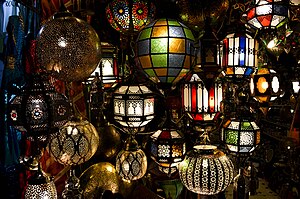
An electric light, lamp, or light bulb is an electrical component that produces light. It is the most common form of artificial lighting. Lamps usually have a base made of ceramic, metal, glass, or plastic, which secures the lamp in the socket of a light fixture, which is often called a "lamp" as well. The electrical connection to the socket may be made with a screw-thread base, two metal pins, two metal caps or a bayonet mount.
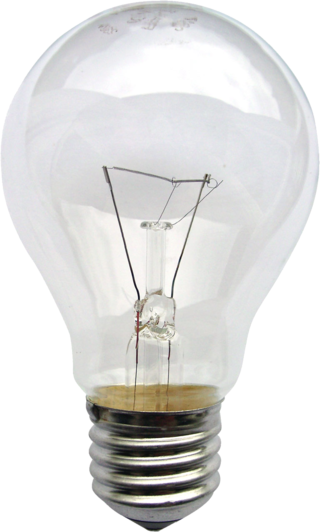
An incandescent light bulb, incandescent lamp or incandescent light globe is an electric light with a wire filament that is heated until it glows. The filament is enclosed in a glass bulb that is either evacuated or filled with inert gas to protect the filament from oxidation. Current is supplied to the filament by terminals or wires embedded in the glass. A bulb socket provides mechanical support and electrical connections.
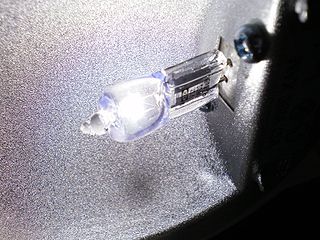
A halogen lamp is an incandescent lamp consisting of a tungsten filament sealed in a compact transparent envelope that is filled with a mixture of an inert gas and a small amount of a halogen, such as iodine or bromine. The combination of the halogen gas and the tungsten filament produces a halogen-cycle chemical reaction, which redeposits evaporated tungsten on the filament, increasing its life and maintaining the clarity of the envelope. This allows the filament to operate at a higher temperature than a standard incandescent lamp of similar power and operating life; this also produces light with higher luminous efficacy and color temperature. The small size of halogen lamps permits their use in compact optical systems for projectors and illumination. The small glass envelope may be enclosed in a much larger outer glass bulb, which has a lower temperature, protects the inner bulb from contamination, and makes the bulb mechanically more similar to a conventional lamp.

Artificial lighting technology began to be developed tens of thousands of years ago and continues to be refined in the present day.
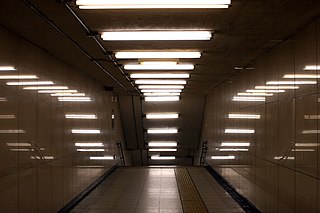
A fluorescent lamp, or fluorescent tube, is a low-pressure mercury-vapor gas-discharge lamp that uses fluorescence to produce visible light. An electric current in the gas excites mercury vapor, which produces short-wave ultraviolet light that then causes a phosphor coating on the inside of the lamp to glow. A fluorescent lamp converts electrical energy into useful light much more efficiently than an incandescent lamp. The typical luminous efficacy of fluorescent lighting systems is 50–100 lumens per watt, several times the efficacy of incandescent bulbs with comparable light output. For comparison, the luminous efficacy of an incandescent bulb may only be 16 lumens per watt.

A sodium-vapor lamp is a gas-discharge lamp that uses sodium in an excited state to produce light at a characteristic wavelength near 589 nm.
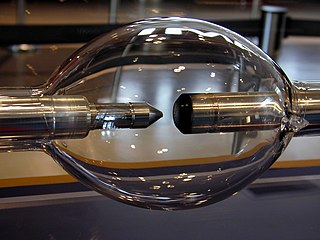
High-intensity discharge lamps are a type of electrical gas-discharge lamp which produces light by means of an electric arc between tungsten electrodes housed inside a translucent or transparent fused quartz or fused alumina arc tube. This tube is filled with noble gas and often also contains suitable metal or metal salts. The noble gas enables the arc's initial strike. Once the arc is started, it heats and evaporates the metallic admixture. Its presence in the arc plasma greatly increases the intensity of visible light produced by the arc for a given power input, as the metals have many emission spectral lines in the visible part of the spectrum. High-intensity discharge lamps are a type of arc lamp.

A mercury-vapor lamp is a gas-discharge lamp that uses an electric arc through vaporized mercury to produce light. The arc discharge is generally confined to a small fused quartz arc tube mounted within a larger soda lime or borosilicate glass bulb. The outer bulb may be clear or coated with a phosphor; in either case, the outer bulb provides thermal insulation, protection from the ultraviolet radiation the light produces, and a convenient mounting for the fused quartz arc tube.
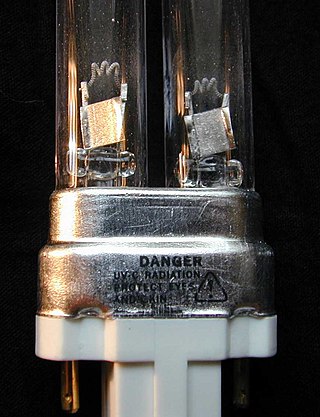
A germicidal lamp is an electric light that produces ultraviolet C (UVC) light. This short-wave ultraviolet light disrupts DNA base pairing, causing formation of pyrimidine dimers, and leads to the inactivation of bacteria, viruses, and protozoans. It can also be used to produce ozone for water disinfection. They are used in ultraviolet germicidal irradiation (UVGI).

A metal-halide lamp is an electrical lamp that produces light by an electric arc through a gaseous mixture of vaporized mercury and metal halides. It is a type of high-intensity discharge (HID) gas discharge lamp. Developed in the 1960s, they are similar to mercury vapor lamps, but contain additional metal halide compounds in the quartz arc tube, which improve the efficiency and color rendition of the light. The most common metal halide compound used is sodium iodide. Once the arc tube reaches its running temperature, the sodium dissociates from the iodine, adding orange and reds to the lamp's spectrum from the sodium D line as the metal ionizes. As a result, metal-halide lamps have high luminous efficacy of around 75–100 lumens per watt, which is about twice that of mercury vapor lights and 3 to 5 times that of incandescent lights and produce an intense white light. Lamp life is 6,000 to 15,000 hours. As one of the most efficient sources of high CRI white light, metal halides as of 2005 were the fastest growing segment of the lighting industry. They are used for wide area overhead lighting of commercial, industrial, and public places, such as parking lots, sports arenas, factories, and retail stores, as well as residential security lighting, automotive headlamps and indoor cannabis grow operations.
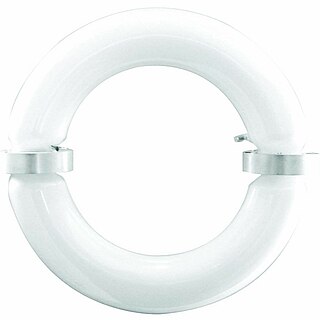
The induction lamp, electrodeless lamp, or electrodeless induction lamp is a gas-discharge lamp in which an electric or magnetic field transfers the power required to generate light from outside the lamp envelope to the gas inside. This is in contrast to a typical gas discharge lamp that uses internal electrodes connected to the power supply by conductors that pass through the lamp envelope. Eliminating the internal electrodes provides two advantages:
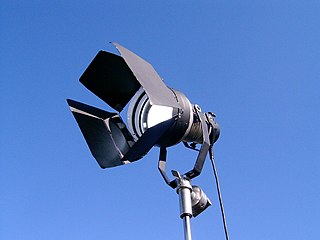
Hydrargyrum medium-arc iodide (HMI) is the trademark name of Osram's brand of metal-halide gas discharge medium arc-length lamp, made specifically for film and entertainment applications. Hydrargyrum comes from the Greek name for the element mercury.

A xenon arc lamp is a highly specialized type of gas discharge lamp, an electric light that produces light by passing electricity through ionized xenon gas at high pressure. It produces a bright white light to simulate sunlight, with applications in movie projectors in theaters, in searchlights, and for specialized uses in industry and research. For instance, Xenon arc lamps with mercury lamps are the two most common lamps used in wide-field fluorescence microscopes

A ceramic metal-halide lamp (CMH), also generically known as a ceramic discharge metal-halide (CDM) lamp, is a type of metal-halide lamp that is 10–20% more efficient than the traditional quartz metal halide and produces a superior color rendition.

Gas-discharge lamps are a family of artificial light sources that generate light by sending an electric discharge through an ionized gas, a plasma.

A grow light is an electric light to help plants grow. Grow lights either attempt to provide a light spectrum similar to that of the sun, or to provide a spectrum that is more tailored to the needs of the plants being cultivated. Outdoor conditions are mimicked with varying colour temperatures and spectral outputs from the grow light, as well as varying the intensity of the lamps. Depending on the type of plant being cultivated, the stage of cultivation, and the photoperiod required by the plants, specific ranges of spectrum, luminous efficacy and color temperature are desirable for use with specific plants and time periods.
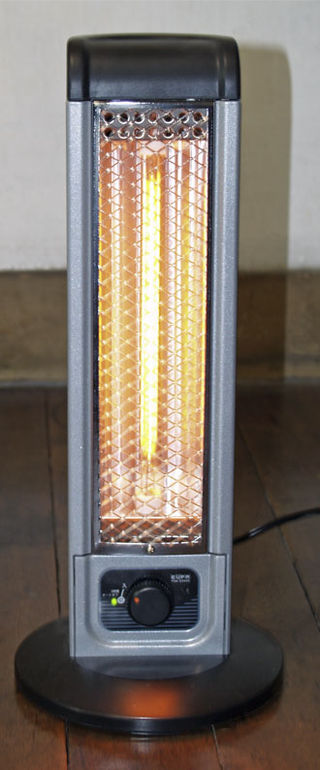
An infrared heater or heat lamp is a heating appliance containing a high-temperature emitter that transfers energy to a cooler object through electromagnetic radiation. Depending on the temperature of the emitter, the wavelength of the peak of the infrared radiation ranges from 750 nm to 1 mm. No contact or medium between the emitter and cool object is needed for the energy transfer. Infrared heaters can be operated in vacuum or atmosphere.
U-HID is a type of lamp. A mixture of two physical principles in lighting electronics, U-HID is the combination of Plasma and High Intensity Discharge (HID) technologies. The U-HID lamp produces a beam of light due to the formation of a plasma discharge arc. Its tube is made of a sphere of transparent quartz or ceramic filled with a special inactive high pressure gas. Through the plasma formation in its core, the atoms outside the chamber produce light. At the beginning of the plasma formation, a blue color at the tips of the inner glass insulation can be seen. This can be considered a characteristic of the technology.
Havells Sylvania and formerly SLI, is an international designer and manufacturer of lighting products, trading as Sylvania. It has plants throughout Europe, Asia, North Africa and Central and South America, and is one of the few lighting companies that produces both lamps and lighting fixtures. It is owned by Shanghai Feilo Acoustics Ltd., having previously been owned by the Indian electrical company Havells.


















